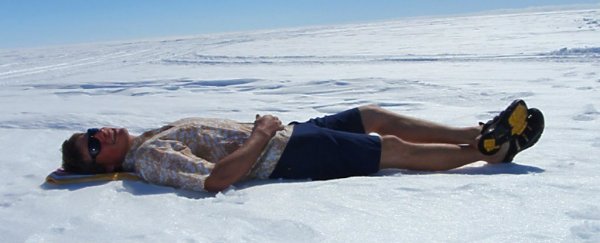We've been hearing a lot about how Antarctica is in seriously dire straights right now, with a massive rift in the Larsen ice shelf gaining 10 km (6.2 miles) in 2017 alone, and a vast, 2-km-wide (1.2-mile) crater signalling that our planet's southernmost landmass isn't as stable as we once thought.
Now, the World Meteorological Organisation (WMO) has verified new "record-high temperatures" for Antarctica, and they're more than a little unsettling - in recent history, the coldest continent on Earth has hit a positively balmy 19.8°C (67.6°F), and 17.5°C (63.5°F).
"The temperatures we announced today are the absolute limit to what we have measured in Antarctica," says Randy Cerveny from Arizona State University and the WMO.
"Comparing them to other places around the world and seeing how other places have changed in relation to Antarctica gives us a much better understanding of how climate interacts, and how changes in one part of the world can impact other places."
And there's a bit of good news here to tide you over - that record-high temperature of 19.8°C didn't happen in the past few years as you might expect, given all the crazy summers we've been having lately.
The WMO reports that the highest temperature in recorded history for the Antarctic Region - defined as all land and ice south of 60°S - was observed on 30 January 1982 at Signy Research Station.
But the highest temperature for the Antarctic continent - defined as the main continental landmass and adjoining islands - happened only recently, with 17.5°C being recorded on 24 March 2015 at the Argentine Research Base Esperanza near the northern tip of the Antarctic Peninsula.
The Antarctic Peninsula is the northwest tip near South America, and is now one the fastest warming regions of the planet, gaining almost 3°C over the last 50 years.
This new record high of 17.5°C for the Antarctic continent replaces the previous record of 15°C (59°F) taken at the Vanda Station on 5 January 1974.
The highest temperature for the Antarctic Plateau - defined as at or above 2,500 metres (8,202 feet) - was -7.0°C (19.4°F), recorded on 28 December 1980 at an Automatic Weather Station (AWS) site on the Adélie Coast.
The lowest temperature ever recorded for the Antarctic Region - and for the whole world - has been verified at -89.2°C (-128.6°F), and was taken at Vostok station at the southern Pole of Cold on 21 July 1983.
While the WMO has verified these as the official highest and lowest temperatures ever for the region, its researchers do point out that even greater extremes are likely to have occurred in the Antarctic Region.
"As with all WMO evaluations, the extremes are identified based on only those events with available high-quality ground-based data," they explain.
These temperatures are the result of years of research by the WMO's international evaluation committee of climatologists and meteorologists to bring us the new official records for the continent.
And after carefully verifying measurements from a number of different sources to give us the most accurate records to date, the WMO's new benchmarks reveal just how massive the range in temperature has become for the coldest place on the planet.
Somehow, a place with averages that range from −10°C on the Antarctic coast to −60°C at the highest parts of the interior managed to hit 19.8°C - similar to the temperatures felt in Sydney last week as its summer months drew to a close.
Cerveny explains that two of the three highest temperatures they've now verified were the result of 'foehn' winds - also known as Chinook winds - which are very warm downslope winds that can heat up an area extremely rapidly.
As Marshall Shepherd reports for Forbes, these winds are frequent, but not well-studied in Antarctica, and appear to get their warmth from a phenomenon known as adiabatic compression, where air travelling down one side of a mountain is compressed to become extremely warm and dry.
Strangely enough, these winds have been linked to a number of severe glacial collapses on the east side of the Antarctic Peninsula over the past 30 years, but no one noticed until recently.
According to Douglas Fox at National Geographic, many were striking in the dead of winter, causing glacier erosion at a time when researchers didn't even think it was even possible.
"The Antarctic Peninsula is the only barrier [to these winds] - the only thing they have to slam into," glaciologist Erin Pettit from the University of Alaska told Fox last year.
And us humans aren't off the hook for all of this, because these winds are caused by subtle changes in the atmospheric circulation due to increased global warming.
Now that we've seen the results in Antarctica, the researchers are cautioning that this is a clear warning sign for regions elsewhere on the globe.
"The polar regions of our planet have been termed the 'canary' in our global environment. Because of their sensitivity to climate changes, sometimes the first influences of changes in our global environment can be seen in the north and south polar regions," Cerveny says in a press statement.
"Knowledge of the weather extremes in these locations therefore becomes particularly important to the entire world. The more we know of this critically important area to our environment, the more we can understand how all of our global environments are interlinked."
More details of the WMO's findings have been reported by Eos Earth and Space Science News from the American Geophysical Union.
